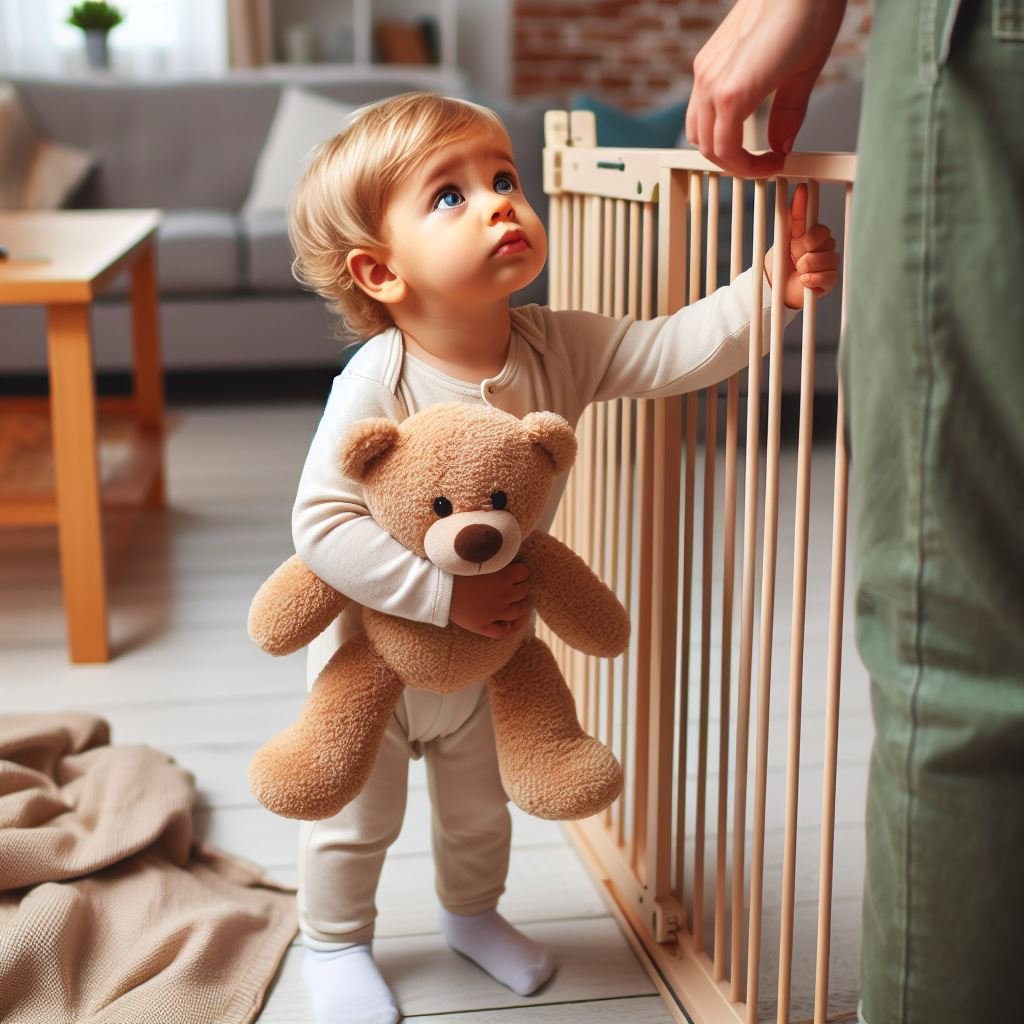What Age Do People Stop Using Baby Gates?
Did you know that 85% of parents continue using baby gates longer than necessary? Knowing when to remove a baby gate is crucial for your child’s development and safety.
In this article, we will explore the factors to consider, age milestones, and signs that indicate it’s time to remove a baby’s gates. We will also provide tips for transitioning away from them gradually.
Don’t fall prey to common misconceptions; let us guide you in making the best decision for your child’s independence and well-being.
Key Takeaways
- The decision to remove gates for babies should be based on factors such as the overall safety level of the home, potential hazards, and the child’s physical abilities and understanding of safety rules.
- Age milestones such as a child’s ability to climb stairs confidently and navigate obstacles, as well as their understanding of safety rules and ability to follow instructions, may indicate that it’s time to remove.
- Signs that a child is ready to navigate the home without using baby gates include consistently following instructions, demonstrating good judgment, becoming more physically capable, and confidently navigating stairs without assistance.
- Gradually transitioning away from using baby gates involves creating a safe environment, establishing boundaries, providing supervision, encouraging independence, and using baby monitors or keeping doors open for increased visibility and communication.
Factors to Consider When Determining When to Remove Baby Gates
One important factor to consider when determining when to remove baby gates is the overall safety level of the home. Parents or caregivers should assess the potential hazards and risks present in the living environment. This includes evaluating the accessibility of stairs, sharp edges, electrical outlets, and other potential dangers that a child can encounter. It is crucial to ensure that the child is developmentally ready to navigate these potential hazards independently without the need for physical barriers like baby gates.
Another factor to consider is the child’s physical abilities and motor skills. As children grow and develop, their ability to climb, balance, and explore their surroundings improves. It is essential to observe the child’s mobility and coordination to assess if they are capable of safely navigating the home without the need for baby gates.
Furthermore, parents should also consider the child’s level of understanding and ability to follow instructions. Removing baby gates too early can pose a risk if the child is not yet capable of understanding safety guidelines and boundaries. It is important to ensure that the child comprehends and can adhere to household rules before removing the barriers.
Age Milestones That May Indicate It’s Time to Remove Baby Gates
The child’s physical and cognitive development are key indicators of when it may be appropriate to remove baby gates. As children grow and develop, they become more capable of navigating their environment safely.
Here are some age milestones that may indicate it’s time to remove baby gates:
- Motor skills:
- When a child starts to climb stairs confidently and without assistance, it may be a sign that they are ready to have the baby gate removed. This milestone shows that they have developed the balance and coordination necessary to navigate stairs safely.
- When a child can navigate other obstacles in the house, such as stepping over thresholds or crawling under furniture, it demonstrates their increased physical abilities and may suggest that the baby gate is no longer necessary.
- Cognitive abilities:
- When a child demonstrates an understanding of safety rules and boundaries, such as not touching dangerous objects or staying away from certain areas of the house, it may indicate that they are ready for the removal of baby gates. This milestone shows that they have developed the cognitive skills necessary to understand and follow instructions.
Signs That Your Child Is Ready to Navigate the Home Without Baby Gates
Independently, children demonstrate the confidence and awareness necessary to navigate the home without the use of baby gates. As parents, it is crucial to recognize the signs that indicate your child is ready to navigate their surroundings without the need for these safety measures. One of the most evident signs is when your child consistently follows instructions and understands boundaries. They show awareness of potential hazards and respond appropriately. Additionally, if your child consistently demonstrates good judgment and is able to make safe decisions, this may indicate their readiness to navigate the home without baby gates.
Another sign to look out for is when your child becomes more coordinated and physically capable. They are able to navigate stairs confidently without assistance and can open and close doors safely. Furthermore, if your child consistently shows an interest in exploring new areas of the house and actively seeks independence, it may be a sign that they are ready to navigate the home without using baby gates.
It is important to remember that every child develops at their own pace, so it is essential to observe their readiness on an individual basis. By recognizing these signs, you can confidently remove the baby gates and allow your child to explore their environment independently while ensuring their safety.
Tips for Gradually Transitioning Away From Baby Gates
When transitioning away from baby gates, it is important to consider a few key tips that can help facilitate a smooth and gradual process.
The transition from using baby gates to allowing your child to freely navigate the home can be both exciting and nerve-wracking. Here are some tips to help you make this transition as seamless as possible:
- Create a safe environment: Before removing the baby gates, take the time to thoroughly childproof your home. Cover electrical outlets, secure furniture, and remove any potential hazards that could pose a danger to your child.
- Introduce boundaries: While using baby gates provides a physical barrier, it is essential to establish boundaries with your child. Talk to them about areas of the house that are off-limits and explain the reasons behind these restrictions. Reinforce these boundaries consistently.
- Supervise and monitor: As you gradually remove baby gates, keep a close eye on your child and provide supervision. Use baby monitors or keep doors open to ensure you can always see and hear your child.
- Encourage independence: Allow your child to explore and navigate their surroundings independently. Encourage them to climb stairs safely, open doors, and move around the house confidently.
By following these tips, you can help your child transition away from baby gates in a way that prioritizes their safety while fostering their independence.
Common Misconceptions About When to Stop Using Baby Gates
One common misconception about stopping the use of baby gates is assuming that it solely depends on a child’s age. While age can be a factor, it is not the only determining factor when it comes to when to stop using baby gates. Every child develops at their own pace, and their ability to navigate stairs and other potential hazards may vary. It is crucial to consider a child’s individual readiness and capabilities when deciding to remove baby gates.
Another misconception is that once a child can walk or climb stairs independently, baby gates are no longer necessary. While it is true that a child’s physical abilities play a role, their understanding of safety and ability to follow instructions are equally important. A child may be physically capable of climbing stairs, but they may not have developed the cognitive skills to understand the dangers associated with stairs or other potential hazards in the home.
Furthermore, some parents believe that once a child reaches a certain age, they no longer need baby gates. However, it is essential to understand that accidents can still happen, regardless of a child’s age. Even older children can be curious and unpredictable, and having baby gates in place can help prevent accidents and keep them safe.
Frequently Asked Questions
How Do I Choose the Right Type of Baby Gates for My Home?
When choosing the right type of baby gate for your home, consider factors such as the child’s age, mobility, and the specific areas in need of restriction. Look for gates that meet safety standards and are easy to install and use.
Are there any safety precautions I should take when removing baby gates?
When removing baby gates, it is important to prioritize safety. This involves ensuring that the area is still secure and free from hazards, implementing alternative safety measures, and closely monitoring the child’s behavior and developmental milestones.
Can I use baby gates for pets instead of children?
Baby gates can be used for both children and pets. They serve as a safety measure to prevent access to certain areas. However, the age at which people stop using baby gates for children may vary depending on individual circumstances.
What Are Some Alternative Safety Measures I Can Take If I Decide to Remove Baby Gates?
Alternative safety measures to consider after removing baby gates include installing door knob covers, securing furniture to walls, using window locks and guards, implementing electrical outlet covers, and teaching children about safety rules and boundaries.
Are there any circumstances where it is recommended to keep baby gates up longer than usual?
There may be certain circumstances where it is recommended to keep baby gates up longer than usual. Factors such as a child’s developmental delays or safety concerns in the home may warrant extended use of baby gates.
Conclusion
In conclusion, there are several factors to consider when determining when to remove baby gates. This includes age milestones and signs of readiness in a child. It is important to gradually transition away from baby gates, taking into account the child’s development and safety.
Common misconceptions about when to stop using baby gates should be addressed to ensure a smooth transition for the child.






